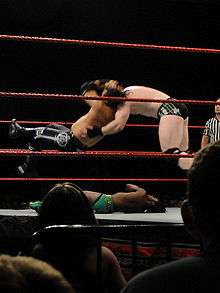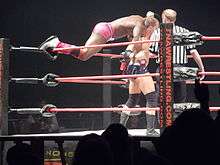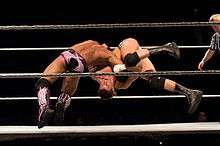Cutter (professional wrestling)
In professional wrestling, a cutter is a ¾ facelock bulldog[1] maneuver. This move sees an attacking wrestler first apply a ¾ facelock (reaching back and grabbing the head of an opponent, thus pulling the opponent's jaw above the wrestler's shoulder) before falling backwards (sometimes after running forwards first) to force the opponent face-first to the mat below.


The cutter was innovated by Johnny Ace, who called it the Ace Crusher.[1] It was later popularized by Diamond Dallas Page, who called it the Diamond Cutter, which is where the move got its name. The cutter also formed the base for the later development of another professional wrestling move known as the stunner.
Variations
Argentine cutter
The attacking wrestler gets his opponent in the Argentine backbreaker position as to execute the Argentine Backbreaker drop. The attacking wrestler then pushes his opponents legs so that he flips horizontally 180 degrees. As his opponents weight is being shifted to one side, the attacking wrestler applies the ¾ facelock and drops his opponent.
Back suplex cutter
This variation sees the wrestler lift an opponent from behind as with a belly to back suplex. Then, instead of falling backwards, the wrestler pushes the opponent's legs so that the opponent turns over in mid-air so that they are now face down and parallel to the ground. As the opponent falls, the wrestler reaches back and seizes the opponent's head in order to perform the cutter.
Crucifix cutter
In this version, the wrestler first lifts the opponent up in a crucifix hold before rotating them into the cutter. Another variation involves the opponent lifted in a reverse crucifix and dropped into the cutter. This particular version was innovated and popularized in America by Tommy Dreamer, who called it the TommyHawk.
Elevated cutter

With an opponent placed on an elevated surface, a wrestler applies a ¾ facelock and then draws the opponent away, leaving only the opponent's feet over the elevated surface. The wrestler then falls backwards so that the opponent is forced to dive forward onto the top of their head due to the angle of which they are dropped. The elevated cutter can also be performed as a double team maneuver including several variations including the doomsday-style elevated cutter or the 3D.It' used by Danny Burch.
Fireman's carry cutter
Also known as the TKO (short for Total Knock Out), and innovated by Marc Mero. It is another elevated cutter variation in which the opponent is first raised over the shoulders of a wrestler in the fireman's carry position. From here, the attacking wrestler twists the opposite way and quickly switches back throwing the legs of the opponent out backwards and drops down to the mat while taking hold of the opponent's head to force him to fall into a high impact cutter. Nikki Bella used this move calling it Rack Attack 2.0.Scorpio Sky uses this move as the TKO. WWE wrestler Austin Theory uses the move as the ATL
Forward somersault cutter
A standing variation of the Diamond Dust in which the attacking wrestler jumps forward into a somersault over a seated or kneeling opponent while applying an inverted facelock, landing back-first with the opponent's face driven into the mat. A stunner variation is also possible. This move was innovated by Jason Kincaid calling it Grave of the Fireflies.Jillian Hall used this move at one point. WWE wrestler Charlotte Flair uses this move as her finisher, calling it Natural Selection
Front facelock cutter
This cutter variation sees the wrestler first lock his opponent in a front facelock or an inverted front facelock. The wrestler then pivots 180° and catches the opponent in a ¾ facelock with their free arm before falling down into the cutter. This move is commonly known as the Twist of Fate, and is associated with Jeff and Matt Hardy, as well as the latter's former real-life girlfriend, Lita.
Handspring cutter
The wrestler performs a handspring and, as they jump backwards, they grab their opponent in a ¾ facelock and fall backwards, dropping the opponent face-first into the mat.It's used by Penelope Ford
Inverted suplex cutter
This variation sees the attacking wrestler execute an inverted suplex lift on his opponent before bringing him down face first with the cutter. Also known as the Osaka Street Cutter.
Jumping cutter
This cutter variation sees the wrestler jumping towards the opponent and grabbing the opponent's head in a ¾ facelock while parallel to the ground, and then slamming the opponent's face to the mat in a cutter. This move is highly popularized by Randy Orton as his Finishing move called RKO. Karl Anderson and Tama Tonga use this variation named the Gun Stun.
Over-the-shoulder cutter
Also known as a powerslam cutter, this variation sees the wrestler lifting the opponent onto their shoulders as in a front powerslam. Then as the opponent is on the shoulder, the wrestler holds the head of the opponent and jumps and slams the opponent face-first to the mat in a cutter. The facebuster variation also exists.
Over-the-shoulder flip cutter
Also known as an Yokosuka cutter; in this variation, the wrestler first lifts the opponent, so that they are lying face up across one of the wrestler's shoulders as in a Canadian backbreaker rack, before flipping the opponent over into the cutter. It is common for the wrestler to not properly apply the ¾ facelock and the move to end up more in a facebuster position. The move was innovated by Susumu Yokosuka and has since been used by several other wrestlers.
Rolling cutter

This version of a cutter sees the wrestler place an opponent in an inverted facelock then spinning under the opponent while holding the facelock, twisting him or her into the cutter position. This move has two major variants. The first, an Inward rolling cutter, in which the attacking wrestler rolls under their opponent while using their free arm to grab the opponent's nearest free arm or striking their back in an upward motion to power the move, is widely referred to as the Roll of the Dice and was popularized in North America by Reno and Christopher Daniels, the latter of whom calls it the Last Rites. Kassius Ohno also popularized the move as his finisher, called the Hero's Welcome. AEW wrestler Cody also uses this variation as a finisher, calling it Cross Rhodes, Damian Priest uses this move as his finisher he calls it "The Reckoning". A modified version which involves hoisting the opponent off their feet before beginning the spin has also been used by other wrestlers. Current WWE wrestler Bo Dallas used this move, calling it Rollin' the Dice.
The second major variation, which is known as an Outward rolling cutter and referred to as a Whirling Dervish in Japan, sees the wrestler spin in the opposite direction while holding onto the opponent's free arm while twisting for leverage.
Running cutter
This variation occurs when the wrestler runs up to the opponent while distracted/stunned etc. And will apply a ¾ facelock while parallel to the ground, and then slamming the opponent's face to the mat in a cutter.
Springboard cutter
This variation of the cutter occurs when the wrestler puts his opponent in the ¾ facelock then usually runs towards the ropes, then jumps onto the second or third rope to bounce off it, turning in the air to land the cutter. This move was popularized by Spike Dudley, originally calling it the Acid Drop, and later Dudley Dog in WWE.
Another variation of this cutter, called Sliced Bread Number 2, was popularized by Brian Kendrick. In this cutter the opponent and the attacker are in the corner, the attacker puts the opponent in the ¾ facelock then runs up the turnbuckle, becoming vertical, then turns in mid-air to land the cutter. The move is similar to the shiranui.
There's a variation as where both wrestlers faces the ropes or turnbuckle. The attacking wrestler runs and jumps on the ropes and bounces back. As they fall, they catch the opponent into a ¾ facelock and drops them in the cutter. This variation is popularized by Will Ospreay and is called the OsCutter.
See also
References
- Melok, Bobby (2013-03-26). "Who invented the RKO? The innovators behind sports-entertainment's best maneuvers". WWE.com. Retrieved 2015-11-02.